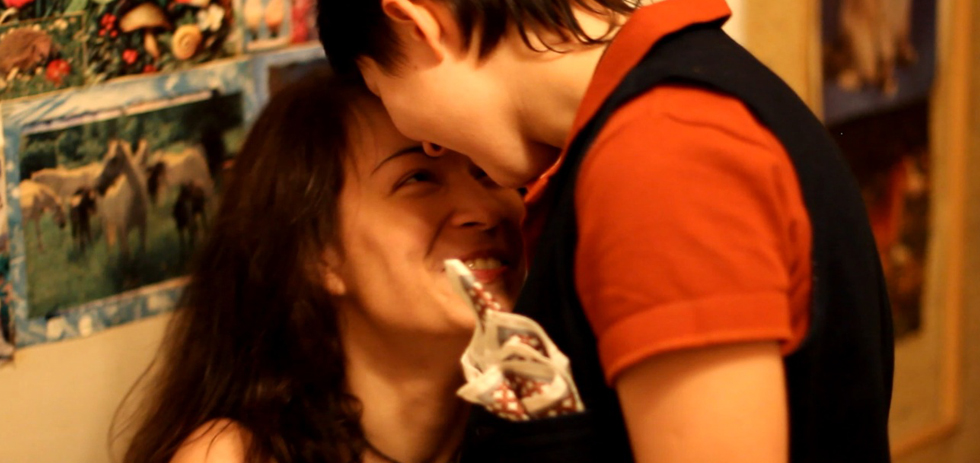
A film that encapsulates the ‘personal is political’ Olya’s Love seats us in the modest Moscow; home for a young Russian queer activist, the titular Olya. Throughout, this observational documentary provides an intimate glimpse at queer lives – with Olya as the centre point – as they navigate the harsh terrain of Putin’s Russia. Choosing a narrow view on the subject director Kirill Sakharnov produces a vulnerable character profile of Olya, one that examines the power systemic oppression has in eroding self-confidence and our closest relationships.
The film opens with Olya defined by her passion; for the LGBTIQ+ movement at large and for her girlfriend Galya. We meet the couple two years into their relationship as they are shown sharing an apartment, referring to one another as ‘wife’ and discussing plans to have a child. They are depicted as an unshakable couple, filled with tenderness and devotion for one another. They are portrayed as two people who fight together for their rights to live and love as queer women. The women have developed a surrogate family with their fellow queer activists and spend their time dancing between endless rallies, kiss-ins, art shows and community organizing.
Olya is established almost immediately as an deeply endearing protagonist with a tireless commitment to the cause; facing the extreme violence of counter-protests by Christian fundamentalists and police brutality, with calmness and a selfless caring for the safety her friends. Her determination and optimism, however, begins to wane with the introduction of new LGBT propaganda laws that further restrict queer community building and civil liberties. As attacks by the orthodox anti-gay groups increase and Olya sinks into a deep depression, a distance is created between her and Galya. The inevitable breakdown of their relationship leaves Olya devastated; estranging her from her friend group and her activism. Olya’s loss of love is nothing out of the ordinary. It is however rendered heartbreaking within the context of anti-gay prejiduce in Russia, which means ‘at least we have each other’ feels like a vital lifeline.
The film is light on formal interviews, instead revelling in the organic conversations characters have with one another in the comfort of their homes. While the documentaries position on the oppression of queer communities in Russia is clear, Sakharnov achieves well in his restraint – allowing Olya and her peers to speak for themselves. This is punctuated by the subject filmed moments in the documentary. By Olya and Galya taking control of the camera the film becomes a further embodiment of queer activists carving their own truths into existence.
Sakharnov relies on hand held camera work for almost the entirety of the film, producing a fluidity and motion that speaks to the rushed momentum of Olya’s exhausting world of activism and community work. With his loose cinematography Sakharnov tracks the women well in every space. He employs reoccurring slow zooms of Olya and Galya as they embrace throughout. A constant yoyo-ing rhythm operates between these small shared moments of peace between the two women and the wide-shot shaky scenes of violence. By seamlessly peppering the mundane and domestic narrative of a relationship in turmoil with these moments of cruelty the documentary reflects the terrifying reality of violence for queer people in Russia as we see characters seemingly unphased by the everdayness of these attacks.
Olya’s Love finds its subdued end in the fall-out of the film’s fuelling drama. Having relocated to St Petersberg to attend art school Olya has left behind the trauma of front line activism and the home of her heartbreak. With a final sequence in which Olya, topless and moustached, reads out an anti-homophobia poem to a room of peers we see a young woman empowered and out in the world on her own. With this unexpected tonal shift, the film ends on a note of celebration of the self. Thus, Sakharnov’s documentary and it’s serendipitous conclusion produces an important statement about the thriving existence of queer identity, politics and sexuality even in the absence of queer romantic love. With the subject of Olya’s Love shifting from Galya to herself the film resituates the site of queer love and identity; reclaiming queerness from something that exists and is given validation by the presence of romantic connections to something self-determined and defined. Olya’s Love is not the political expose on Russian institutional homophobia that many audiences may be hungry for. Where this film shines in its smallness, documenting just one woman’s dynamic path to queer self-love.
